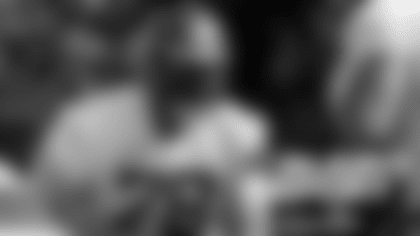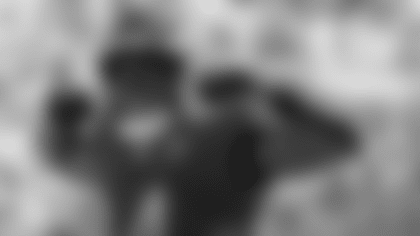Buccaneers Head Trainer Todd Toriscelli says much of being a
It's not the injuries he can see that particularly concern Todd Toriscelli.
It's those violent moments that leave no visible evidence of injury – and have no particular measurables for recovery, either – that can be a dilemma for Toriscelli and his fellow NFL trainers.
Toriscelli is the Tampa Bay Buccaneers' head athletic trainer, has been since 1997. In his eight seasons in charge of the health of hundreds of professional athletes, he has seen a huge variety of injuries. That's a fact of life in the NFL. Some are harder to look at than others and some take longer to heal, but none are more indeterminate and thus more troubling than concussions and other head trauma.
That's why Toriscelli and his NFL peers spend a great deal of time studying the issue, pooling their data and resources to work towards a standard program of diagnosis and treatment for concussions and head trauma. It's an issue the league takes very seriously, and its work on the matter has begun to trickle down to the college and high school levels, promising safer play for all injuries.
It's a difficult issue, but not one that can be ignored.
So how do we know that head injuries are the ones that Toriscelli and his fellow NFL trainers find most difficult to treat? Because you asked.
Or, more specifically, RJ of Bradenton, Florida asked. As the latest guest in the "Your Turn" interview series, Toriscelli was put on the hot seat for a round of questions sent in by Buccaneers fans using Buccaneers.com. From the hundreds of queries submitted, 20 were selected for presentation to Toriscelli in the fans' own words, including RJ's. Read on for Toriscelli's response, in his own words.
Below is a full transcript of the first half of that interview, questions 1-10. You can also watch the video of the interview, using the links below this story, in the Buccaneer Broadcast Network box on the home page or here in the Video Archive. The second half of Toriscelli's fan-driven interview will appear on Buccaneers.com later in the week.
**
Your Turn with Todd Toriscelli, Part 1
- Lee H. Igel of Largo, Florida asks:
It seems likely (obvious) that there are both physical and mental components to the injury & rehabilitation process. How do you and your training team deal with the mental side of things? How much of a factor does sport psychology play in your work?
Toriscelli: "We don't do too much in sports psychology. I think that in other sports it's probably different, but in football, unfortunately, injuries are such a big part of everyday life here, it's almost like players are used to dealing with injuries and the rehab process. It's part of what they do; they have to struggle with those things. In addition to that and our medical staff, there's a support system here, in-house, with the coaches and a guy like Cedric Saunders, who's the director of player development. Those individuals are there to help guys through. There is a very team atmosphere here. This team is pretty unique in that way, in that there is a lot of support coming from the players themselves, and that helps me in my job. We don't have any formal sports psychology, but I think informally there's a good support question here for our guys."
**
- Robert A. of Midlothian, Texas asks:
I have seen many times a player has a broken arm or dislocated shoulder and still plays in a game. How do y'all get the players to forget the pain and play effectively while they have serious injuries?
Toriscelli: "That's a great question. I ask myself that all the time and I've been doing this for a long time. It's amazing what these guys can do with so many injuries that they have. It really is. We do the standard things medically to try to make things as pain-free as possible. In the NFL, you have 16 games, you only have 16 chances, so guys are very motivated not to miss out on a game. I don't think it's anything we do. I mean, we try to do things to protect the injuries that exist until they heal, but I think that comes from within."
**
- Rick of Tucson, Arizona asks:
How is your job different when it comes to keeping older players healthy vs. younger players? Do you work with the players as a group or is individual training more important when trying to keep the team healthy?
Toriscelli: "I think that, looking at a college football team, everybody is in the same age group and in the same physical condition. So the conditioning program at the collegiate level is more standardized for everybody. Here in the NFL, we have an offseason where most of our players training here, and I think our strength and conditioning staff has a great program for everybody. But the difference is the age, because you're going to train a 30 to 35-year-old player differently than you would one who is coming out of college. The older guys have already physically developed as much as they're going to. I think their program would shift more towards injury prevention and performance, whereas I think, and I think our strength staff would agree, that the younger players would still have some upside, physically. There's still some room to develop. The other factor is that the older players, particularly in [training] camp, you just can't do as much with them. You're not trying to 'preserve' them, just trying to be smart with the amount of repetitions and the extra things that you do that the younger guys can tolerate physically."
**
- Vincent Curtaz of Richmond, California asks:
I wanted to know your opinion on free weights as opposed to Nautilus type machines/weights [as it relates to injuries].
Toriscelli: "I think that's a good question. Where we are now is the perfect blend of machines and free weights. If it's done properly, I don't think there is an advantage of machines over free weights. I haven't seen that. But I think what we do here now, with the combination of both, [works]. What gets people in trouble in the weight room is trying to over-train, trying to push too much weight. I think people get caught up – particularly high school athletes – in how much they bench press and how much they do. They lose sight of the fact that you basically condition to have that development transfer to the field, and to prevent injury. It's not so much how you bench. I think the way you use the machines or the free weights is how people get in trouble. I don't think it's the method by which you train."
**
- A.J. DiLorenzo of Tampa, Florida asks:
Whenever a player hurts his knee, the terms MCL tear and ACL tear are mentioned. I know where these two tendons are on the knee, but which of the two tears is most damaging to an NFL player's continued career?
Toriscelli: "I would say that you would think the ACL. Today, that is still the issue, because it's a much longer recovery because of how you have to fix it. Now, with an MCL, which is a ligament located on the outside of the knee, there's no surgery involved. It's a relatively short recovery, probably two or three months, whereas an ACL involves an open procedure and eight to nine, 10-month recovery. So, to answer that question, the ACL would probably threaten a player's career more."
Moderator: "As examples, Mike Alstott's two knee injuries were MCLs?"
Toriscelli: "He had MCL injuries, right."
Moderator: "And he was out for about a month?"
Toriscelli: "Right. Twenty years ago, or 25 years ago, an ACL [injury] was very damaging to your career. But I think that just medically we have become better at fixing them and rehabbing the injury. Unfortunately, it's very common so you have a lot of practice."
**
- RJ of Bradenton, Florida asks:
What is the hardest injury to approach, and why?
Toriscelli: "I can tell you that head injuries are, and that's a big concern in the NFL right now for all of us. It's not so much the major head trauma but the mild traumatic brain injuries that are a big issue in the NFL right now, the mild injuries to the head that lack any objective symptoms. For example, a broken bone you can see on an X-ray; a pulled muscle you can test the player's strength. But head injuries are a mystery. You're trying to decide how bad they are and when a player should go back. We're working real hard to try to solve that as best we can and try to protect our players."
Moderator: "For a lot of injuries, such as the MCL we were talking about a little while ago, when a player gets an injury you already have a pretty good idea of how long they will be out. And you're saying with a head injury, people are still trying to figure out what that normal [treatment] time is."
Toriscelli: "Right. With the MCL, you can document healing, as well. But with concussions it's hard to establish exactly the extent of the injury initially, and also when is the guy ready to go back, or is the player still going to be exposed to a high risk of injury when he goes back. You don't want to put them in that situation."
**
- Kristin M. of Wallingford, Connecticut asks:
You hear a lot in sports about certain guys being "fast healers" – that is, they seem to recover from injuries more quickly than most other players. Do you think there is such a thing as a fast healer, and if so, why is this the case for some players?
Toriscelli: "No question. I've seen it, I'm convinced. I think there are two issues. Number one, physiologically, some people just heal faster than others. I've seen many X-rays over the years, and you just see fractures heal faster on some people than others. But I think that probably the number one factor in healing is motivation and attitude, and that's been proven with cancer patients. When they maintain a positive attitude, they have a much better success rate of being healthy again. I see that with our players. The guys who are upbeat and positive and really motivated to come back tend to do a lot better and heal a lot of faster. Fortunately on our team, that's true with the majority of players that we have. As I said, there are two factors there, the actual physiological factor and the psychological factor that I know have a lot to do with the rate."
**
- Steve Avigne of Southgate, Michigan asks:
What was the worst injury you have experienced in your medical career and your time spent with the Buccaneers?
Toriscelli: "We've had a couple tibia fractures, which is a total break of the shin bone, basically. That's a really big injury. It's just hard to deal with on the field. It's hard to look at, and it's hard because you know the player's career is temporarily over with. That's a big fracture, and we've had a couple since I've been here. We just don't like to see that."
**
- Carsten Dollerup of Copenhagen, Denmark asks:
The sheer amount of pulls and hamstring injuries in the NFL lead me to ask, how focused are teams are on avoiding injuries (i. e. how much focus is on stretching after a workout, taking care of your body)? Also, I'm curious to know whether for example reflexology and other "non-traditional" methods are applied when helping players back from injuries or surgery?
Toriscelli: "To answer the first part of that question, we do a lot of things to try to prevent injuries. That starts in the offseason when we analyze injury patterns that we've experienced the past year and compare them to previous years. I think the whole league does that. For example, injuries were up this year, particularly lower-extremity injuries. We're trying to study, is this a trend that's starting, or is it just a one-year aberration? But we do a lot of stretching. A lot of things we do in our conditioning program are geared towards not only conditioning our players and performance, but injury prevention. That's why the strength and conditioning staff we have is critical to what we do. Then, of course, there is the whole issue of heat. We take drastic measures to try to prevent heat injury. But muscle injuries in camp are a real concern, and we do take steps [to avoid them].
"As far as non-traditional methods that are available medically, we do do some things, such as acupuncture, and I have a massage therapist on staff. However, I can tell you that we don't experiment with our players. We like to use proven methods that are approved by our physicians, and not so much the latest fad. I think there's a lot of that in pro sports, and it filters down to the college and high school kids. You've just got to be careful, and again the whole supplement industry is another thing. We just try to do things that we feel comfortable with, that work and that are proven and have been around for awhile."
**
- Kevin Wilson of Memphis, Tennessee asks:
Is there any difference between college football and the NFL when it comes to the emphasis between getting players on the field and keeping them healthy?
Toriscelli: "I think the biggest difference – I was a college trainer for seven years before I came here, so I've kind of lived both lives – I think at the collegiate level practice is so important. Everywhere I was at, there was a rule that if a player was injured and couldn't practice Wednesday or Thursday they wouldn't play in the game. In the NFL, practice is also critical, especially at certain positions. However, if a player just can't practice, then the goal shifts towards trying to get him ready for the game, because they're just more experienced. You limit guys in practice as much as needed. In the NFL, the emphasis is on the game."
























